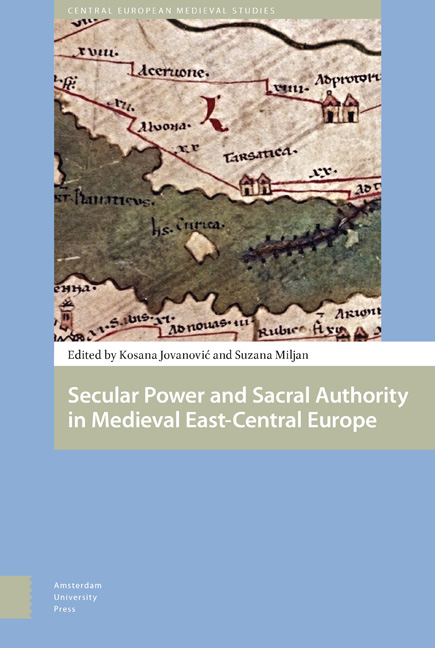Book contents
- Frontmatter
- Contents
- List of Figures and Tables
- Acknowledgements
- Foreword
- Folklore of the Medieval Kings of Hungary: Preliminary Research Report
- Variations on Nobility in Central and South-Eastern Europe: An Introduction
- The Changes of Office of Ban of Slavonia after the Mongol Invasion in Hungary (1242-1267)
- The Reconstruction and Role of Roads in the Formation of a Medieval Cultural Landscape: The Example of Episcopal Estates of Dubrava, Ivanić and Čazma
- From Castle-Warrior to Nobleman: Case Study of a Family of Slavonian Lesser Nobility
- Late Medieval Village in Turopolje (Slavonia): The Example of Donja Lomnica
- Economic Development and Transformation of the Pauline Monasteries near Senj under the Frankapan Patronage
- The Society of the Noble Judges in Northeastern Hungary during the Reign of King Sigismund (1387-1437)
- Development of Ragusan Diplomatic Service in the First Half of the Fifteenth Century: Father and Son at the Court of Duke Sandalj Hranić
- Croatian Students at the University of Prague in the Fifteenth Century
- A Contribution to Medieval Croatian Diplomatics: Cyrillic Charters of Croatian Nobility from the Franciscan Monastery on Trsat in Rijeka
- Peter of Crkvica, a Man Who Could Be Trusted: The Career of a Middle-Ranking Cleric and Diplomat in the Kingdom of Hungary in Mid-Fifteenth Century
- The Nobility of the Despotate of Serbia between Ottoman Empire and Hungary (1457-1459)
- List of Contributors
- Index
A Contribution to Medieval Croatian Diplomatics: Cyrillic Charters of Croatian Nobility from the Franciscan Monastery on Trsat in Rijeka
Published online by Cambridge University Press: 12 December 2020
- Frontmatter
- Contents
- List of Figures and Tables
- Acknowledgements
- Foreword
- Folklore of the Medieval Kings of Hungary: Preliminary Research Report
- Variations on Nobility in Central and South-Eastern Europe: An Introduction
- The Changes of Office of Ban of Slavonia after the Mongol Invasion in Hungary (1242-1267)
- The Reconstruction and Role of Roads in the Formation of a Medieval Cultural Landscape: The Example of Episcopal Estates of Dubrava, Ivanić and Čazma
- From Castle-Warrior to Nobleman: Case Study of a Family of Slavonian Lesser Nobility
- Late Medieval Village in Turopolje (Slavonia): The Example of Donja Lomnica
- Economic Development and Transformation of the Pauline Monasteries near Senj under the Frankapan Patronage
- The Society of the Noble Judges in Northeastern Hungary during the Reign of King Sigismund (1387-1437)
- Development of Ragusan Diplomatic Service in the First Half of the Fifteenth Century: Father and Son at the Court of Duke Sandalj Hranić
- Croatian Students at the University of Prague in the Fifteenth Century
- A Contribution to Medieval Croatian Diplomatics: Cyrillic Charters of Croatian Nobility from the Franciscan Monastery on Trsat in Rijeka
- Peter of Crkvica, a Man Who Could Be Trusted: The Career of a Middle-Ranking Cleric and Diplomat in the Kingdom of Hungary in Mid-Fifteenth Century
- The Nobility of the Despotate of Serbia between Ottoman Empire and Hungary (1457-1459)
- List of Contributors
- Index
Summary
Cyrillic diplomatic literacy in Croatia has its roots in the Byzantine Reconquista of Dalmatia from ninth to eleventh century, as well as in the temporary but strong influence of the Bulgarian state during the time of Emperors Simeon and Samuel. It is for these reasons that the Cyrillic alphabet, as the more recent Slavic script, stabilized in the area of presentday Dalmatia (or, from a medieval perspective, in Dalmatia and southern Croatia). The Greek language subsided and consequently fell out of use, but the Cyrillic letters remained dominant in the aforementioned region for composing texts in Slavic vernacular. The Glagolitic script dominated in the northern part of the Kingdom of Croatia-Dalmatia, while in the Kingdom of Slavonia, whose direct connections with the Frankish state and Hungary were much stronger, the Latin language and script took absolute primacy, and the remains of the medieval Slavic literacy are rudimentary.
In the medieval period up until the end of fifteenth century, Croatian epigraphic, liturgical, literary and legal texts in Cyrillic script are preserved in a substantially larger number than diplomatic materials (diplomata et acta). Today we know of only twenty Cyrillic charters and letters of Croatian nobility which were issued up until 1500. Eight of them (40%) are located in the Franciscan monastery on Trsat in the city of Rijeka. No other archive or archival collection has more than two Cyrillic documents of Croatian noblemen in its holdings. The National Archives in Dubrovnik and the National Archives of Hungary in Budapest hold two such documents each, while the Croatian State Archives in Zagreb, Parish Office in Pučišća (on the island of Brač) and the Cathedral Archive in Split (in the form of transumption in the document of Spalatin Cathedral Chapter) hold one each. Two documents are currently unaccounted for, while one was most probably destroyed in the First World War in the Archive of the Counts of Attems, near Gorizia in Italy.
Territorially, all these documentary monuments of Croatian Cyrillic literacy are linked with the region south of the river Zrmanja and most of them (all except one) with even smaller area in the present-day Dalmatia – between the rivers Krka and Neretva. Due to the scarceness of preserved copies, it is not known to what extent the Slavonic (i.e. Croatian) language and script were used in this region in comparison with the Latin language.
- Type
- Chapter
- Information
- Publisher: Amsterdam University PressPrint publication year: 2018



